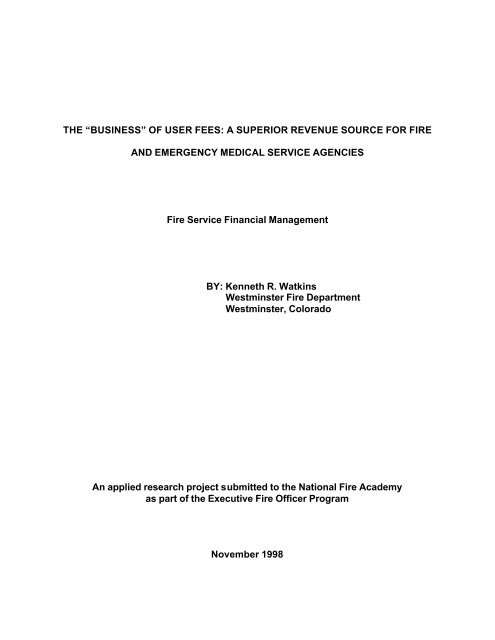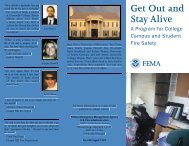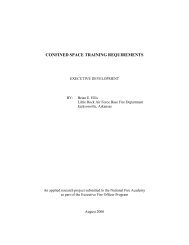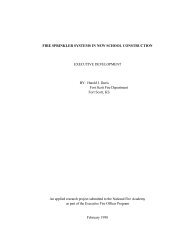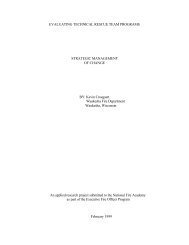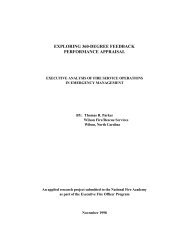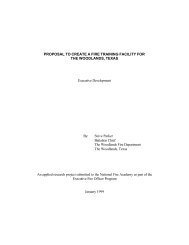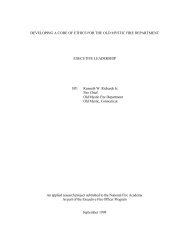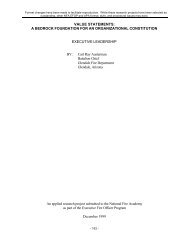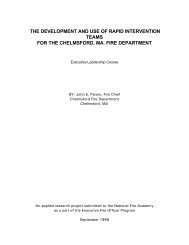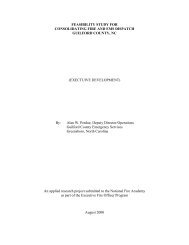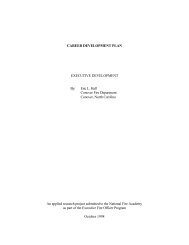"Business" of User Fees - US Fire Administration - Federal ...
"Business" of User Fees - US Fire Administration - Federal ...
"Business" of User Fees - US Fire Administration - Federal ...
Create successful ePaper yourself
Turn your PDF publications into a flip-book with our unique Google optimized e-Paper software.
THE “B<strong>US</strong>INESS” OF <strong>US</strong>ER FEES: A SUPERIOR REVENUE SOURCE FOR FIREAND EMERGENCY MEDICAL SERVICE AGENCIES<strong>Fire</strong> Service Financial ManagementBY: Kenneth R. WatkinsWestminster <strong>Fire</strong> DepartmentWestminster, ColoradoAn applied research project submitted to the National <strong>Fire</strong> Academyas part <strong>of</strong> the Executive <strong>Fire</strong> Officer ProgramNovember 1998
2ABSTRACTThis research project reviewed alternative funding for fire and emergencymedical service agencies, and specifically user fees as a superior revenue source tosupplement traditional tax revenues. The Westminster <strong>Fire</strong> Department wasconsidering expanding its user fee program in anticipation <strong>of</strong> a downturn in sales taxrevenue. The problem was that before expanding fees or implementing new ones thedepartment needed a better understanding <strong>of</strong> user fees and what type <strong>of</strong> fees havebeen successful in other fire departments.The purpose <strong>of</strong> this research is to define user fees, evaluate related benefits andconcerns <strong>of</strong> fee-based services, determine types <strong>of</strong> fees assessed by other firedepartments, and decide whether the Westminster <strong>Fire</strong> Department should expand itsuser fee programs. Descriptive and evaluative research was used to answer thefollowing research questions:1. What are user fees and what types are other fire departments charging theircustomers?2. What are the benefits and problems associated with user fees?3. What steps can be taken to “sell” these fees to the decision-makers, thepublic, and the employee group?The research methodology consisted <strong>of</strong> a literature review <strong>of</strong> fire service andgovernment publications in order to define user fees and associated benefits andconcerns. A survey was also conducted <strong>of</strong> fire departments in Colorado to ascertainwhat types <strong>of</strong> fee-based services were in place.
3The major findings <strong>of</strong> this research clearly answered the research questions andgenerated ideas that the author will use to propose expanding current and new fees thatprovide a higher level <strong>of</strong> service to Westminster customers. Specific recommendationswill be re-inspection and false fire alarm fees to gain compliance with codes and servicerequirements. Additionally, the department will evaluate a non-emergent interfacilityambulance transport program as a new service at the request <strong>of</strong> the City Manager.
4TABLE OF CONTENTSAbstract....................................................................................................................................... 2Table <strong>of</strong> Contents ...................................................................................................................... 4Introduction................................................................................................................................. 5Background and Significance.................................................................................................. 7Literature Review ...................................................................................................................... 9Procedures ...............................................................................................................................21Results ......................................................................................................................................23Discussion................................................................................................................................26Recommendations ..................................................................................................................28References ...............................................................................................................................30Appendix A (<strong>User</strong> Fee Survey) ........................................................................................... A-1Appendix B (Survey Results) .............................................................................................. B-1
5INTRODUCTIONThe “business” <strong>of</strong> government has changed dramatically over the last few years.For many government agencies the only thing that has remained constant is continuouschange. Many <strong>of</strong> these changes originated in business and then spilled over togovernment. In the private sector customers have come to expect a certain level <strong>of</strong>service and this expectation has also migrated to the public sector. Terms such ascustomer service, empowerment and total quality management have become commonin both business and government alike.Generally, these changes have been positive for both the public and privatesectors. They have made government more accountable, more user-friendly, andraised service levels. Many governments, especially at the local level have added newand innovative services in response to customer requests and from ideas generatedfrom empowered employees. Another viewpoint by Kemp (1991) is “The magnitudeand momentum <strong>of</strong> these changes will influence the types <strong>of</strong> public services provided inthe future – how they will be financed and how well they will meet the citizens’ needs”(p. 48). This has been evident by the many government agencies that have alreadybeen doing “more with less” but still continue to add services for their citizens, stretchingexisting resources to make everything fit. For other agencies that have been blessedwith a good economy; population and economic growth have also increased thedemand for service.The Westminster <strong>Fire</strong> Department has experienced both <strong>of</strong> these scenarios overthe last few years. Whether in lean or prosperous times customer service hascontinued to improve and expand with minimal budget increases. Currently the
6department is enjoying a comfortable level <strong>of</strong> prosperity due to numerous years <strong>of</strong>growth and a strong local economy. However, a new shopping mall under developmentin a neighboring city is anticipated to siphon away 10-15% <strong>of</strong> the city’s sales taxrevenues – a major source <strong>of</strong> income. In anticipation <strong>of</strong> this projected downturn in taxrevenue Westminster has been exploring various ways to <strong>of</strong>fset the revenue loss. TheCity Manager has directed departments to brainstorm ideas to counteract this downturn,while hopefully maintaining existing services.One area that the fire department has been considering is an expansion <strong>of</strong> feesthe department charges and to identify new fees that are acceptable to City<strong>Administration</strong>, City Council and Westminster citizens. Current department fees aremainly related to ambulance transport and fire prevention activities but there is a desireto look for different and innovative ways to supplement the city revenue base. Theproblem was that before expanding fees or implementing new ones the departmentneeded a better understanding <strong>of</strong> user fees and what type <strong>of</strong> fees have been successfulin other fire departments.The purpose <strong>of</strong> this research is to define user fees, evaluate related benefits andconcerns <strong>of</strong> fee-based services, determine types <strong>of</strong> fees assessed by other firedepartments, and decide whether the Westminster <strong>Fire</strong> Department should expand itsuser fee programs.Descriptive and evaluative research was used to answer the following researchquestions:1. What are user fees and what types are other fire departments charging theircustomers?
72. What are the benefits and problems associated with user fees?3. What steps can be taken to “sell” these fees to the decision-makers, thepublic, and the employee group?BACKGROUND AND SIGNIFICANCELike most cities, Westminster gains the majority <strong>of</strong> its revenue through variousforms <strong>of</strong> taxes. While the trend across the country has been an anti-tax sentiment,Westminster has enjoyed a level <strong>of</strong> success from its citizens in approving new taxes.However, the city was surprised when a recent admissions tax (for entertainmentvenues) that was slated for public safety was defeated by a 2 - 1 margin at the polls.Many state and local governments have enacted a variety <strong>of</strong> tax limitation measuresthat limit the ability <strong>of</strong> communities to raise taxes or spend excess revenue. In 1992,Colorado enacted the Taxpayer’s Bill <strong>of</strong> Rights (TABOR), “the most restrictive revenueand spending limit placed upon state and local governments in the nation (Jacobs,1998, p. J1). Since adoption, Colorado government agencies have struggled to meetthe requirements <strong>of</strong> the amendment and still provide a high level <strong>of</strong> service.During the 1980’s, The Westminster <strong>Fire</strong> Department was operating under the“more with less” philosophy, and trying to provide the highest level <strong>of</strong> service with a leanstaff. This philosophy carried over into the 1990’s even though the department hasenjoyed a sizable amount <strong>of</strong> economic prosperity fueled by a dramatic increase ingrowth and economic development. Over these two decades the department has beenvery progressive in <strong>of</strong>fering new and innovative services with minimal budget increases.Economic development has always been important to local government but inlight <strong>of</strong> tax limitations, it has become even more popular as a way to increase revenue
8without having to go to the voters. Like many cities, Westminster has touted economicdevelopment as a way to bring in new taxes and increase revenue for services. Thelast few years the City has been very successful in this effort. Many new businesseshave moved to the City and many existing businesses have expanded in light <strong>of</strong> arobust economy. Increased population growth has accompanied this economicprosperity spurring an annual population increase <strong>of</strong> 3-5% over the last few years.Besides growth, changing demographics have also effected services. Anincrease in the aged population and short-term transient population increases due toentertainment and shopping venues have increased strain on departmental services.This strain is evident in employee workload, whether through a higher number <strong>of</strong> callsfor service or a greater demand on the fire prevention bureau to keep up with planreview and inspection loads.As a way to address some <strong>of</strong> this demand the Westminster <strong>Fire</strong> Department hasbeen exploring new ways to generate revenue to continue meeting existing servicedemands and provide for the future. While researching various types <strong>of</strong> alternativefunding, the idea <strong>of</strong> expanding user fees seemed a good way to increase revenue andalso provide a level <strong>of</strong> to citizens. While a majority <strong>of</strong> citizens pay taxes for city servicesincluding fire and rescue, only a minority actually uses these services. <strong>User</strong> fees allowcustomers to pay for the services they use and allow the department to expand intoservices that more citizens may enjoy. In addition, since the department was alreadycharging some fees and had a billing procedure in place, user fees would be a quickmethod <strong>of</strong> <strong>of</strong>fsetting the anticipated revenue decline.
9The majority <strong>of</strong> Westminster’s revenue comes from sales tax, with theWestminster Mall being the largest contributor. A neighboring community has begunconstruction on a new mall that is anticipated to siphon away approximately 10-15% <strong>of</strong>Westminster’s sales tax revenue. With the recent rejection at the polls <strong>of</strong> theadmissions tax, new fees may need to <strong>of</strong>fset this anticipated revenue loss in order tomaintain the services that Westminster citizens expect.This research is intended to allow the author a better understanding <strong>of</strong> user feesin order to access current departmental fees, compare them with fees from other firedepartments, and decide on any new or expanded fees. In addition, the research willlook for which fees are more acceptable and the best way to enact these fees. Thisresearch project relates to Unit VII <strong>of</strong> the <strong>Fire</strong> Service Financial Management coursepresented at the National <strong>Fire</strong> Academy. The unit discussed alternative funding for firedepartments, including user fees as a way to supplement traditional revenue sources.LITERATURE REVIEWWhen California voters passed Proposition 13 in 1978 they started a taxlimitation movement that spread throughout the country. To some this was a surprise,but according to the National <strong>Fire</strong> Academy <strong>Fire</strong> Service Financial Managementtextbook it was actually a predictable outcome <strong>of</strong> three economic conditions.First, a major expansion <strong>of</strong> local government services caused expenditures toincrease 564 percent from 1959 to 1970. Second, federal financial assistancedeclined 67 percent from 1979 to 1989. Finally, local governments placed toogreat a burden on their primary revenue source – the local property tax (FEMA,1997).
10Colorado joined the movement in 1992 when voters passed the TABOR Amendmentwhich, limits increases in revenue and spending to a formula based on inflation pluspopulation growth. Since its passage various jurisdictions have waffled between a fear<strong>of</strong> fiscal crisis, finding ways to get around the limitations, or working to secure othertypes <strong>of</strong> funding.The fire service has not been immune to tax limitation and has had to learn tooperate within the confines <strong>of</strong> these laws and budget limitations. Dipoli (1997) states:Although the impact <strong>of</strong> these restrictions were minimal at first, the drive toconstrain government spending continues to create hardship for fire andemergency service agencies. With the fire service facing the same increases incost for personnel, equipment, facilities and the general delivery andadministration <strong>of</strong> services, similar to other government agencies, there is aconstant pressure to find sources for new funds (p.10).Many fire departments have found these new funds by developing superior revenuesources through various types <strong>of</strong> alternative funding. The <strong>Fire</strong> Service FinancialManagement textbook states:In addition to providing a positive cash flow, the superior source <strong>of</strong> revenuepromotes equity, encourages efficiency, raises morale, gathers public/politicalsupport, rewards behavior that contributes to the quality <strong>of</strong> life, and discouragesinjurious behavior, while remaining consistent with the fire department’s mission(FEMA, 1997,p. SM 7-3).There are numerous types <strong>of</strong> alternative funding mechanisms that the fire servicehas utilized in recent years. Sources such as fundraising, grants, investments, cost
11sharing, lease/purchasing, subscriptions, impact fees and probably the most common –cost recovery or user fees. This research will focus mainly on user fees in order toanswer the research questions.<strong>User</strong> <strong>Fees</strong> DefinedThe research showed that user fees can be defined in many ways, however acommon one expressed by Berman (1997) is, “voluntary payments based on anindividual’s consumption <strong>of</strong> goods and services” (p.68). The Government FinanceOfficers Association Catalog <strong>of</strong> Public <strong>Fees</strong> and Charges defines user fees as“beneficiary charges as payments made by consumers in direct exchange for servicereceived” (Withers, 1994, p. 3). <strong>User</strong> fees are meant to be a form <strong>of</strong> cost recovery forservices and not for pr<strong>of</strong>it making. Normally they will not pay for the service entirely butwill enable the agency to continue <strong>of</strong>fering the service based on the supplementalrevenue generated. Berman (1997) finds that “Since the mid 1970’s, user fees havebecome so popular that three-quarters <strong>of</strong> local governments in the United States and anumber in Canada have adopted them in one form or another” (p. 68).Fee TypesThe popularity <strong>of</strong> user fees has spawned a large variety <strong>of</strong> fees collected bygovernment agencies.The concept <strong>of</strong> charging a fee for the prevention and suppression <strong>of</strong> a fire is notnew. The insurance companies we know today evolved from the prevention <strong>of</strong>fire losses. Being insured meant property owners paid a fee to insure that fireprotection would be provided when needed. (Manion, 1996, p. 6).
12Today, departments have gone beyond the traditional firemark (a symbol denotinginsurance membership) used during Ben Franklin’s time. The United States <strong>Fire</strong><strong>Administration</strong> in its book, A Guide to Funding Alternatives for <strong>Fire</strong> and EmergencyMedical Service Departments lists the following as the more common fees charged byfire and emergency medical service agencies (FEMA, 1993).• <strong>Fire</strong> prevention fees i.e. permit fees, inspection fees, plans review fees and falsealarm fees• Emergency Medical Service (EMS) and transport fees• <strong>Fire</strong> suppression and rescue fees• Cost recovery for routine fire and hazardous materials response• Standby and fireguard fees• Special services• Training feesThe literature review revealed the most popular form <strong>of</strong> user fees is for fireprevention activities. Permit fees are usually related to administrative costs associatedwith new and remodeled construction projects, and for many unsafe processes such ascontrolled burns, fireworks, welding, flammable liquid storage, etc. <strong>Fire</strong> departmentsusually have legal authority to assess these types <strong>of</strong> fees under a section in their firecode.For a number <strong>of</strong> years, fire inspection fees have probably been the mostcommon fire prevention fee. According to the United States <strong>Fire</strong> <strong>Administration</strong>“inspection fees have long been used by fire departments to <strong>of</strong>fset prevention costs,and are well-accepted” (FEMA, 1993, p. 22). These continue to be popular as a
13revenue source and as a way to gain compliance under the fire code. Inspection feescan however, act as a “double-edged sword”. The willingness to correct violations bythe occupant during the inspection has increased among those charging fire inspectionfees. There was however, some concern that inspection fees can harm the relationshipthe department has with the business community and may have a negative effect on thefire prevention program (Godwin, 1995). This concern has prompted many to be morein favor <strong>of</strong> charging for re-inspections than initial inspections. “Charging a fee for theseservices may only increase resistance to regular inspections. However, it may be wiseto begin charging for the increasing numbers <strong>of</strong> re-inspections” (Wenke, 1995, p. 16).Dean (1995) suggests that “<strong>Fees</strong> charged for inspections that are required by thedepartment or municipality may cause some political or legal problems, however feesfor re-inspections are quite different” (p. 5).<strong>Fees</strong> associated with false fire alarms are also popular because <strong>of</strong> theircompliance value. Similar to fees that police departments’ charge for responding t<strong>of</strong>alse burglar alarms, the fire service has begun to address concerns over the amount <strong>of</strong>false alarms responses. Oak Brook, Illinois a highly commercialized village in themetropolitan Chicago area found that out <strong>of</strong> 600-700 calls per year to alarms systems,more than 80% were false (Nielsen, 1995). “Each false alarm response created somedanger for the public and the firefighters. Valuable resources are used unnecessarily,and the units are not available for actual fires or other calls”(FEMA, 1993, p. 55).Charging a fee for these types <strong>of</strong> responses helps address the concern <strong>of</strong> alarm systemmaintenance and provides safety for firefighters and the public. Most agencies that
14charge this fee allow businesses a set number <strong>of</strong> false alarms per month or year beforethey incur any charges.New codes and economic prosperity has required fire departments to spend agreat deal <strong>of</strong> time reviewing fire protection plans for existing or new construction. Planreview fees have been developed to <strong>of</strong>fset this time requirement and are usually basedon square footage. These fees can reach into thousands <strong>of</strong> dollars for large commercialoccupancies.A limited number <strong>of</strong> agencies have started charging for public educationpresentations, mostly to businesses. While this could be another source <strong>of</strong> revenue, itis not well accepted because <strong>of</strong> concerns that fees could undermine the goals <strong>of</strong> adepartment’s prevention and education program.With the advent <strong>of</strong> many fire departments providing emergency medical servicesmany have begun to charge fees to recover expenses related to providing basic oradvanced life support. Many <strong>of</strong> these agencies were already providing these services,which the private ambulance companies conveniently charged for. The United statesfire <strong>Administration</strong> has found that “as the demand for EMS has increased, jurisdictionshave begun to look for ways to <strong>of</strong>fset some <strong>of</strong> the costs <strong>of</strong> operating EMS and thefirefighting infrastructure that supports basic and advanced life support services”(FEMA, 1993, p. 40). EMS fees are divided into two types - rescue and ambulancetransport fees. Many agencies that don’t provide ambulance transport still may chargea fee for rescue services in order to recover the cost <strong>of</strong> supplies and personnelexpertise. It appears though, that the most lucrative revenue source is in ambulancetransport. <strong>Fire</strong> departments have discovered that they can supplement a large portion
15<strong>of</strong> their revenue base through transport fees, and many times provide a higher level <strong>of</strong>service than the private ambulance companies. The largest payer <strong>of</strong> these fees ismedical insurance companies and Medicare or Medicaid. An interview with Captain D.Hall (personal communication, November 16, 1998) the Westminster <strong>Fire</strong> DepartmentEMS Officer revealed that for 1998 the department is projected to collect over $1 millionin ambulance transport fees. This is based on a 75% collection rate on approximately2500 transports. Ambulance transport fees incorporate a wide range <strong>of</strong> fees including:• Basic Life Support Treatment• Advanced Life Support Treatment• Mileage fee to the hospital• Oxygen• Spinal Immobilization• DisposablesOne concern with ambulance transport fees is that they can effect the people thatmay need an ambulance the most – the poor and elderly. These customers may nothave the means to get to the hospital, let alone pay for the ambulance ride. Somedepartments have initiated subscription programs to help alleviate this concern. It isironic that the “concept <strong>of</strong> subscriptions dates back to the early years <strong>of</strong> our nation,when firemarks on buildings indicated which fire service had been subscribed to, if any”(FEMA, 1993, p. 48). While the modern version <strong>of</strong> subscriptions still may be used forfire response, the new trend is for ambulance transport. Withers (1994) found thatSpringfield, Oregon <strong>Fire</strong> and Life Safety’s <strong>Fire</strong>Med program was an example.
16<strong>Fire</strong>Med members use the ambulance service “free”. <strong>Fire</strong>Med sends a billdirectly to the member’s insurance company for payment whenever the service isused. Any amount not reimbursed by the insurance company is “written-<strong>of</strong>f” – ineffect covered by the annual membership fees (p. 12).Departments that have used subscription programs have found they are a good source<strong>of</strong> steady revenue and also allow opportunity for departmental marketing.An area that may be the next trend in fire service EMS is to charge inter-facilitynon-emergent transport fees. These fees would cover the cost <strong>of</strong> an “ambo-cab”service where patients are transferred between clinics or to return home. Due to thesmall number <strong>of</strong> fire agencies involved in this service the literature was fairly limited.However, Cheverie (1998) suggests “a logical extension <strong>of</strong> the EMS service would be toexpand beyond providing emergency transports to providing inter-facility and nonemergencytransports as well” (p. 26). As this type <strong>of</strong> ambulance transport becomesmore popular and lucrative because <strong>of</strong> insurance contracts, it is likely that more firedepartments will begin to provide this service.Other EMS fees from the research were for EMS standby at events, Helicopterstandby fees, and a driving under the influence (DUI) fee. This fee is collected byrescue agencies from convicted DUI <strong>of</strong>fenders that have caused automobile accidents.Cost recovery for fire response is limited except for subscription programs.However, response fees for special services like hazardous material, and technical ordive rescue are usually charged on an actual cost basis. These funds are used to payfor equipment and the expertise <strong>of</strong> technicians and specialists.
17There are many other miscellaneous fees that fire departments are charging as away to supplement revenue. <strong>Fees</strong> for such things as document preparation; traininginstruction, facility rental, and special event standby are all ways to increase revenue forservices provided that are more than the basic call to 911.<strong>User</strong> Fee BenefitsThe obvious reason for implementing user fees is to generate additional revenuefor the department. <strong>Fees</strong> are a way to bring in revenue without increasing taxes. Foryears the fire service has been thought <strong>of</strong> as a drain on local government financesinstead <strong>of</strong> being a revenue generator. Berman (1997) found that “The funds adepartment “earns” makes it less dependent on the general revenue fund, which helpsto insulate if from the scrutiny <strong>of</strong> politicians” (p.72). Tax limitation and budget shortfallswill continue to make fee collection even more important.Another prime reason for developing user fees is fairness and equity. While alltaxpayers support the basic services, user fees allow the actual user to pay for anyspecial services. According to Starling (1998), user fees fall under the “benefitsreceived principle” where the principle attempts to apply a free-market approach to thedistribution <strong>of</strong> taxes. . .user fees for government goods force individuals to reveal theirwillingness to pay for these goods.An important reason for user fees is to gain compliance and change behavior. Infire prevention, compliance in the inspection program can be gained quicker if thedepartment charges for re-inspections. Wenke (1995) points out that fees “discouragecontractors and businesses from taking fire inspectors’ time for granted, and toencourage speedy compliance” (p. 16). Oak Brook, Illinois found that after they
18implemented a fee for false fire alarms they “noted a decrease in multiple responses tothe same property for the same fire alarm malfunction” (Nielsen, 1995, p. 102).Changing behavior not only can work in fire prevention, but also for EMS byreducing system abuse. While EMS fees “may not reflect the true cost <strong>of</strong> providing theservice, it may serve as both a way to recover some costs as well as serve as adeterrent to misuse or abuse <strong>of</strong> the service” (Dean, 1995, p. 4).It is evident that user fees are a helpful way to generate needed revenue but alsoaccomplish some positive things in the process.The public may benefit from a cost recovery from other ways also. If those whouse the service pay for it, property and other broad based taxes shouldtheoretically remain static or even drop. The public may also force a departmentto revise or dismantle programs it fails to patronize (Berman, 1997, p. 72).<strong>User</strong> Fee ConcernsLaw and ethics are two issues usually mentioned when people think <strong>of</strong>emergency response agencies charging for services. Civilians <strong>of</strong>ten ask how the firedepartment can charge for a service for which they already pay taxes. Elected <strong>of</strong>ficialsand agency managers must respond honestly, explaining the differences between taxesand fees and describe their purpose and benefits (Berman, 1997). One thought is that,when a distinction is made between basic services and advanced services horizons canbe broadened and the possibilities for serving government customers increases(Withers, 1994). It is assumed that taxes would cover the basic services such as firesuppression, whereas user fees would cover advanced services such as ambulancetransport.
19Much <strong>of</strong> the litigation involving user fees centers on whether a charge is anactual fee or a tax that has been disguised as a user fee. Withers (1994) states that,taxes are involuntary contributions to the community treasury designed to raiserevenues. A user fee is a charge imposed upon persons or property in exchange for aparticular government service. The United States Supreme Court has answered thequestion by establishing a three-part test to determine whether a charge is a user fee:• Fee must be identified with a specific government service• Payment must be voluntary – one must request the service in order for thegovernment to impose the fee• Service must directly benefit the person paying the fee (Withers, 1994)Berman (1997) also found that “fees received mustn’t be collected with the purpose <strong>of</strong>raising revenue beyond the cost <strong>of</strong> the provided service” (p. 69). Again, user fees arenot meant to be pr<strong>of</strong>itable, merely able to supplement revenue for providing a service.Once legal issues have been satisfied, support from the community and thedepartment’s policy-making board must be evident for success <strong>of</strong> the fee. Citizens thathave turned down tax increases before don’t want to see the issue reborn as a user fee.A fire department budget must reflect not only what the fire executive wants formonetary policy, but more importantly, it must reflect the policy that the citizenswant. Certain budget priorities may sound very reasonable to the fire chief, whilethe community may have quite a different agenda (Waselchuk, 1997, p.14).Knowing your community and the priorities <strong>of</strong> the citizens and policy makers is a mustfor the success <strong>of</strong> a user fee program.
20“Communication is essential in determining whether fees for service will beaccepted in a community” (Withers, 1994, p.6). Surveys, focus groups, and communitymeetings can be used to gauge public interest in user fees. One department found thatthey could use their department’s public information <strong>of</strong>ficer and local press to theiradvantage. The press can and does make news. . .every week a “success story” aboutsatisfied customers or generated revenue was in the paper (Manion, 1996).Additionally, “great care must be taken not to alienate the department from the publicbecause <strong>of</strong> perceived exorbitant fines and fees” (Waselchuk, 1997).The department’s policy-making board must also be in support <strong>of</strong> the feeprogram. “It is critically important for the local government manager to communicatewith the council or board. The possibility <strong>of</strong> service fees needs to be introduced todecision-makers early in the process” (Withers, 1994, p.6). Policymakers may havespecific reasons whether or not to support fees and being open and up front with thepolicymakers will help solve issues early that may come up.The same considerations must also apply to employees. “Local governmentleaders need to communicate with employees to be certain that they are at ease withcharging for the services they render” (Withers, 1994, p. 6). At times this can cause anethical dilemma for firefighters. They take a great deal <strong>of</strong> pride in the job they do and“collecting” money for services rendered isn’t always accepted. Employee support iscritical for presenting clear and accurate information to the public, which is the key tosuccess <strong>of</strong> any fee program; without their support, the public’s confidence will beundermined (Berman, 1997).
21Establishing a billing program can be a hurdle that the department will have tocontend with. Some agencies elect to handle the billing in-house with departmentemployees whereas; others elect to contract this out to a private business thatspecializes in this type <strong>of</strong> billing. Municipal departments may be able to utilize existingcity personnel that are already involved in billing for other municipal fees, such as waterbills and court fees. Regardless <strong>of</strong> who actually bills the responsible party, thegovernment must establish procedures for collecting billing data along withadministrative and accounting procedures for personnel, bill processing, and internalcontrol (Berman, 1997).The literature review was used to research and understand the definition <strong>of</strong> userfees and discover what types <strong>of</strong> user fees other fire departments are utilizing nationally.In addition, the benefits and concerns <strong>of</strong> user fees was an important aspect <strong>of</strong> thisreview.PROCEDURESThe goal <strong>of</strong> this research was to determine what is a user fee, what types arebeing assessed by other fire departments, what are the benefits and concerns <strong>of</strong> userfees, and how can the Westminster <strong>Fire</strong> Department expand its user fee program. Theresearch was descriptive in that a literature review was conducted through the LearningResource Center at the National <strong>Fire</strong> Academy where a number <strong>of</strong> fire service authorshad written on the subject. Additionally, the author’s home and departmental librarieswere also used.The research was evaluative in that a survey (Appendix A) was conducted toassess fees and fee structures from other fire departments in Colorado. The survey
22consisted <strong>of</strong> general background questions along with a separate checkbox section onactual fees. These fees were divided into the following areas:• Emergency Response• Emergency Medical• <strong>Fire</strong> Prevention• Public Education and Training• Special Teams• Subscription and Membership <strong>Fees</strong>• Impact <strong>Fees</strong>The survey results (Appendix B) were compiled onto a spreadsheet for ease <strong>of</strong> review.Survey PopulationThe survey was mailed to fifty-five fire departments in Colorado. The majority <strong>of</strong>these departments were from the Colorado Front Range area where the statepopulation is concentrated, and is the same general area as the author’s department.Departments were given three weeks to return the survey either by mail or fax. A total<strong>of</strong> 32 surveys were returned effecting a 58% return rate.A brief interview was also conducted with Westminster <strong>Fire</strong> Department EMSOfficer Doug Hall; to ascertain some specific information related to Westminster’sambulance transport system.Assumptions and LimitationsThe author only surveyed fire departments in Colorado and specifically along theFront Range. Research revealed that user fees are easier to justify if neighboringjurisdictions are also assessing the same type <strong>of</strong> fees. In addition, the departments
23were thought to be progressive organizations that would be more inclined to provideadditional fee-based services. It is assumed that a national survey <strong>of</strong> similar typedepartments would have revealed equivalent results.RESULTSAnswers to Research QuestionsResearch Question 1. The research revealed the criteria to define a user fee.This definition can be answered legally through the three-part Supreme Court definitionor simply as “user fees are charges for voluntarily purchased services that benefitspecific individuals” (Withers, 1994, p. 4). The author discovered a variety <strong>of</strong> differenttypes <strong>of</strong> user fees that other departments were using nationally and specific detail at thestate level. The Guide to Funding Alternatives for <strong>Fire</strong> and Emergency Medical ServiceDepartments (FEMA, 1993) lists the most common type <strong>of</strong> user fees as falling into thesecategories:• <strong>Fire</strong> prevention fees i.e. permit fees, inspection fees, plans review fees and falsealarm fees.• Emergency Medical Service (EMS) and transport fees• <strong>Fire</strong> suppression and rescue fees.• Cost recovery for routine fire and hazardous materials response.• Standby and fireguard fees• Special services• Training feesThe fee survey that was conducted among Colorado fire departments was evenmore helpful in determining which fees are the most popular in the author’s
24geographical area. The survey showed that the Colorado departments followed thenorm <strong>of</strong> fire prevention and ambulance transport fees as the most popular. Anunexpected finding was that Westminster’s fee program was fairly similar to a majority<strong>of</strong> the departments represented in the survey. The author expected to find that thedepartment didn’t charge for as many services, but instead found Westminster onlylacking in a couple areas.Research Question 2. The literature review established four main benefits <strong>of</strong>user fees.• Generate Revenue• Gain Compliance• Change Behavior• EquitableBeing able to generate revenue is a prime reason that local governments elect toestablish user fees in order to provide services. Most agencies probably don’t thinkabout the other positive aspects <strong>of</strong> charging these fees. However, gaining complianceand changing behavior are user fee benefits that a fire department can use tostrengthen its fire prevention program or emergency medical system. Finally, user feesprovide a measure <strong>of</strong> fairness to the community by charging the customer for theservice they receive. While every resident does indeed pay taxes for basic services,many user fees are used to supplement the specialized services, such as ambulancetransport and hazardous material response.
25The research identified user fee concerns in the following categories:• Ethics• Legal• Political Support• Community Support• BillingHistory has answered many <strong>of</strong> the ethical and legal concerns through businesscompetition and legislation. The Supreme Court has established a three-part definition<strong>of</strong> a user fee as:• Fee must be identified with a specific government service• Payment must be voluntary – one must request the service in order for thegovernment to impose the fee• Service must directly benefit the person paying the feeDepartments that are considering a user fee program should ensure that the fees fitthese criteria.Research showed that the best way to gain political and community support wasto maintain open and honest communication with citizens and the policymakers <strong>of</strong> theorganization. “Building public support for difficult financial decisions is a marketingchallenge” (Benest, 1998, p. 3). Being able to show the purpose <strong>of</strong> the fee, its use, andwhere the money will go are ways that can improve an agencies chance <strong>of</strong> feeacceptance and support.Billing concerns depend on which type <strong>of</strong> billing program the department elects touse. <strong>Fire</strong> departments establishing new fee programs may elect to contract the billing
26aspect to an outside vendor. Municipal fire departments may be able to utilize existingbilling personnel in the city organization that are already billing for such things as waterbills and court fines. Lastly, a department may elect to hire its own billing personnel andperform this function in-house. While this system has the most control, it also has thehighest amount or liability and legal issues to contend with in order to perform smoothlyand efficiently.Research Question 3. Berman (1997) found that to “sell user fee programs, onemust explain that they’ll be used to <strong>of</strong>fset the costs <strong>of</strong> providing that service. If it’s donecorrectly opposition will be limited” (p. 71). “Selling” a user fee program or as inWestminster’s case <strong>of</strong> expanding an existing one, depends upon open communicationand marketing. These are the key for the main stakeholders – the public, policymakers,and departmental employees. The survey revealed only four out <strong>of</strong> thirty-twodepartments market their fees however, six departments also noted that they had feesthat were unacceptable, either politically or with their citizens. It is unknown whetherthese departments elected not to market fees because they didn’t see the need orbecause the departments aren’t familiar with marketing concepts.DISC<strong>US</strong>SION<strong>Fire</strong> departments that rely on taxes as their sole revenue source will have adifficult time providing additional services or even maintaining their current ones. Manydepartments that have been “stung” by tax limitation or budget reductions have alreadyrecognized this. The answer to these concerns lies in the philosophy that governmentneeds to be more like business and less like government <strong>of</strong> old. Today, competition isappearing and increasing between units <strong>of</strong> government and private business.
27Competition for customers is pitting business against business, business againstgovernment, and government against government (Withers, 1994). In response,government needs to create ways to generate revenue and supplement taxes in orderto maintain and improve service for the customer.The majority <strong>of</strong> the literature for this research was related to alternative funding ingeneral. Most <strong>of</strong> the authors took a broad view <strong>of</strong> identifying various funding choicesand their use in the fire service. After reviewing the literature the author elected to focuson user fees in order to answer the problem statement established at the beginning <strong>of</strong>the project. The author was able to locate two authors, Berman and Withers thatconcentrated a large part <strong>of</strong> their information on fees. Their material helped the authorfocus on user fees as a superior revenue source for the Westminster <strong>Fire</strong> Department.The descriptive research compelled the author to conduct a survey <strong>of</strong> firedepartments in Colorado to ascertain specific information on user fees <strong>of</strong> neighboringdepartments. The survey was very helpful in giving a “close to home” look at other firedepartments fee programs.The study revealed that Westminster <strong>Fire</strong> Department’s fee-program is similar tomany departments in the area. However, is did reveal areas that could be expanded inorder to generate additional revenue in light <strong>of</strong> the anticipated sales tax decline. Thedepartment’s current fees are well accepted politically and by the community, but anynew fees would be expected to gain acceptance before implementation. The employeegroup has recognized that the department needs to operate more like a business inorder to maintain or expand services for the future. <strong>User</strong> fees can afford the departmentthis opportunity while providing fairness to the taxpayer and the customers.
28RECOMMENDATIONS<strong>Fire</strong> departments that decide to utilize alternative funding usually make thisdecision out <strong>of</strong> necessity to maintain services. For departments that are struggling in atax limitation environment alternative funding may be the key to survival. Departmentsthat are expanding because <strong>of</strong> a healthy economy may also look at user fees for equityreasons. <strong>User</strong> fees can be the answer for both scenarios. “With the growing demandfor monies, lack <strong>of</strong> public support for additional taxes, and increased demands forspecialized services, the fire service executives must decide if fee based services is aneffective tool for the management <strong>of</strong> current and expanded fire service demands”(Manion, 1996, p. 8). <strong>User</strong> fees can generate needed revenue, help gain compliance,change behavior, and effect a sense <strong>of</strong> fairness for services.For Westminster, utilizing and expanding fees is a way to answer cityadministrations request to evaluate alternative funding ideas in preparation for ananticipated sales tax downturn. The research has defined the benefits and concerns <strong>of</strong>user fees, but also generated some ideas for the future. Specifically, Westminsterneeds to create a process <strong>of</strong> evaluating which <strong>of</strong> the fees to pursue, and then plan asystem <strong>of</strong> implementation. After reviewing the survey data the author is recommendingthe department expand its fee program to include fees for re-inspections and false firealarms. These two areas are important in light <strong>of</strong> the significant amount <strong>of</strong> commercialgrowth that the City has experienced. Implementing a non-emergent inter-facilitytransport system is also a concept with merit. Coincidentally as the author wasfinalizing this research project the City Manager requested the department study thisconcept. Any proposal will require planning and open communication with the
29community, city administration, City Council, and the employee group. Martin (1995)reminds us that, “An alternative funding program opens other doors for the firedepartment to interact with its citizens and show the wide array <strong>of</strong> services which areprovided” (p. 16). <strong>User</strong> fees shouldn’t be looked at just as ways to generate revenuebut rather a way to provide customers the highest quality service possible.
30REFERENCESBenest, F. (1998 October). Engaging citizens in the bottom line. IG Newsletter,7, 3.Berman, R. (1997, March/April). Paying the bills. NFPA Jounal, 91, 66-72Cheverie, R. A. (1998). Using non-emergency inter-facility transports to create arevenue stream. Emmitsburg, MD: National <strong>Fire</strong> Academy.Dean, J.C. (1995). Alternative funding sources, operating on more than justtaxes. Emmitsburg, MD: National <strong>Fire</strong> Academy.Dipoli, R. A. (1997, November). 10 capital funding sources that still make sense.Responder, 4, 10+.<strong>Federal</strong> Emergency Management Agency. (1993). A guide to fundingalternatives for fire and emergency medical service departments. (FA 141).Washington DC: U. S. Government Printing Office.<strong>Federal</strong> Emergency Management Agency. (1997). <strong>Fire</strong> service financialmanagement. (FEMA/<strong>US</strong>FA/NFA-FSFM-SM). Emmitsburg, MD.Godwin, R. (1995). Benefits associated with charging for fire inspection fees.Emmitsburg, MD: National <strong>Fire</strong> Academy.Jacobs, J. (1998, March 29). Tabor: taxpayers bill <strong>of</strong> rights or wrongs? TheDenver Post, p. J1.Kemp, R. L. (1991, January). Cities in the year 2000: the forces <strong>of</strong> change. <strong>Fire</strong>Chief, 35, 48-49.
31Manion, K. (1996). Fee Based Services: a managerial analysis relative t<strong>of</strong>inance, public opinion and organizational changes. Emmitsburg, MD: National <strong>Fire</strong>Academy.Martin, W. J. (1995). Alternative funding: a need. Emmitsburg, MD: National<strong>Fire</strong> Academy.Nielsen, R. D. (1995, June). Making fire alarms pay for themselves. <strong>Fire</strong>Engineering, 148, 101-102.Starling G. (1998). Managing the Public Sector. Orlando, FL: Harcourt Brace.Waselchuk, P. (1997). Complications associated with the appropriation <strong>of</strong>alternative funding in the fire service. Emmitsburg, MD: National <strong>Fire</strong> Academy.Wenke, R. (1995). Alternative funding sources for a rural fire district.Emmitsburg, MD: National <strong>Fire</strong> Academy.Withers, G. (1994, December). <strong>Fees</strong> for service in public safety. MIS Report,26, 1-14.
Westminster <strong>Fire</strong>/RescueFee SurveyA-1Department:__________________________________ Population Served:____________Type: Paid____Volunteer____Combination____Number <strong>of</strong> Personnel_______________Does your department charge any user, impact, or subscription fees? Yes____No____If NO, stop here and fax or mail your response to the location listed on the cover letter.If YES, please continue and check which services you charge for and their amount.<strong>User</strong> Fee Type:Fee AmountEmergency Response:____<strong>Fire</strong>______________Rescue__________ (Do not include transport fees)____Hazardous Material______________DUI Caused Accident Fee______________Co-Response with Private Ambulance ______________Other____________________ __________Emergency Medical:____BLS Treatment/Tansport____ALS Treatment/Transport____Teatment/No Transport____Helicopter Standby____Mileage Fee____Disposables____Oxygen____Spinal Immobilization____Special Event Standby____Other________________________________________________________________________________________________________________________<strong>Fire</strong> Prevention:____Company Inspections______________Re-inspections______________Technical Inspections______________Special Event Standby (fire watch) ______________False <strong>Fire</strong> Alarms__________ # <strong>of</strong> Free responses allowed?________Plan Review______________Permit Fee (Code-Based)______________Permit Fee (Non-Code Based __________(Please List ____________________________________________________________________________________Other____________________ __________
<strong>User</strong> Fee Type (con’t):Public Education and Training:____Safety Talks____<strong>Fire</strong> Drills____Extinguisher Training____CPR Training____First Aid Training____Facility Rental____Other____________________Fee Amount______________________________________________________________________A-2Special Teams:(HazMat, Technical Rescue, Dive Team, <strong>Fire</strong> Investigation, etc)____Response <strong>Fees</strong>______________Equipment Replacement______________Personnel Costs______________Other____________________ __________Subscription <strong>Fees</strong>:____<strong>Fire</strong>____Emergency Medical____Other____________________Impact <strong>Fees</strong>:____New Development____Other______________________________________________________________________Who handles your billing?Department____Other Department____Outside Contractor ____What is your collection rate?__________%Have any <strong>of</strong> these fees been politically sensitive or unpopular? If so which ones?____________________________________________________________________________Did you market any <strong>of</strong> these fees prior to establishing them? If so which ones?____________________________________________________________________________Is your population base stable? Yes____No____ If NO, what % does your annual populationincrease? _________%Is this population change due to employment centers, educational institutions, or entertainmentareas? Yes____No____Do you have any special fees that you assess because <strong>of</strong> these increased population areas?Please list____________________________________________________________________Would you like a copy <strong>of</strong> the survey results when completed? Yes____No____Thank you for completing this survey. Please return by October 31, 1998.
WESTMINSTER FEE SURVEY B-1Arvada Berthoud Boulder Boulder Rural Brighton Castle Rock Castlewood CherryvalePopulation 120,000 12,000 96,000 25,000 32,000 18,000 100,000 25,000Paid/Volunteer/Combination Vol Vol Paid Vol Comb. Comb. Paid Vol# <strong>of</strong> personnel 200 52 85 50 50 60 80<strong>User</strong>/Impact/Subscript.fees No Yes Yes Yes No Yes Yes YesBill-Dept/Oth Dept/Contractor Department Department Contractor Contractor DepartmentCollection Rate HM 40%, F/A 45% 75% 76% 90% ?Sensitive or unpopular fees No No ?<strong>Fees</strong> marketed No No In tax districtPopulation base stable? % Yes Yes No, 7% No, 5-7% No,3%Population change Partial Yes No<strong>Fees</strong> for pop. Change Dev. Excise Tax No No No No<strong>US</strong>ER FEE TYPEEMERGENCY RESPONSE<strong>Fire</strong>RescueHazardous Material Eng-$150/hr Actual costDUI Accident FeeCo-Response w/Priv AmbOther Auto rescueEMERGENCY MEDICALNonres 300/hr/appNonres 100/callBLS Treatment/Transport $100/NonRes $400res/$500nr $325ALS Treatment/Transport $400res/$500nr $325Treatment/No Transport$150als/$50blsHelicopter StandbyMileage Fee/Disposables $8/mile $7Oxygen $40 $30Spinal Immobilization $45 $40Special Event Standby Eng-$150/hr 1st hr $100/als, $60bls salary reimbOther IV - $30FIRE PREVENTIONCompany InspectionsRe-Inspections $50-$100 $50Technical Inspections $30-$75/hr $70/hrSpecial Event (fire watch)salary reimbFalse <strong>Fire</strong> Alarms $100-$500 $300 $100# Free Responses allowed 1 in 12 mos. 3 3/monthPlan Review $100-$250 based on sq ft based on sq ft $70/hrPermit Fee (code) $10-$30 $50-200 $62.50-$125Permit Fee (non-code)Other $30/hr - special FA/Spr $30/test $50aft/hr inspPUBLIC ED/TRAININGSafety Talks/<strong>Fire</strong> DrillsCPR/First Aid/Extinguisher Trg15 CPRFacility RentalSPECIAL TEAMSResponse <strong>Fees</strong> wildland-per State actual costsEquipment Replacement actual costs HazMatPersonnel Costs Overtime Rate actual costs HazMatSUBSCRIP/MEMB FEE<strong>Fire</strong> NR$450/hr/app 6.66 mill levy taxEmergency MedicalNR$100/patientIMPACT FEENew Development based on value $70/hr Inspec. $21R/$22/1k sqft com
WESTMINSTER FEE SURVEY B-2Colo Springs Denver Edgewater Englewood Fairmount <strong>Federal</strong> Hts Foothills Genesee GoldenPopulationPaid/Volunteer/Combination# <strong>of</strong> personnel<strong>User</strong>/Impact/Subscript.feesBill-Dept/Oth Dept/ContractorCollection RateSensitive or unpopular fees<strong>Fees</strong> marketedPopulation base stable? %Population change<strong>Fees</strong> for pop. Change<strong>US</strong>ER FEE TYPEEMERGENCY RESPONSE<strong>Fire</strong>RescueHazardous MaterialDUI Accident FeeCo-Response w/Priv AmbOtherEMERGENCY MEDICALBLS Treatment/TransportALS Treatment/TransportTreatment/No TransportHelicopter StandbyMileage Fee/DisposablesOxygenSpinal ImmobilizationSpecial Event StandbyOtherFIRE PREVENTIONCompany InspectionsRe-InspectionsTechnical InspectionsSpecial Event (fire watch)False <strong>Fire</strong> Alarms# Free Responses allowedPlan ReviewPermit Fee (code)Permit Fee (non-code)OtherPUBLIC ED/TRAININGSafety Talks/<strong>Fire</strong> DrillsCPR/First Aid/Extinguisher TrgFacility RentalSPECIAL TEAMSResponse <strong>Fees</strong>Equipment ReplacementPersonnel CostsSUBSCRIP/MEMB FEE<strong>Fire</strong>Emergency MedicalIMPACT FEENew Development320,000 500,000 4,500 30,000 12,000 11,000 6,000 3,770 16,000Paid Paid Vol Paid Comb Comb Comb Comb Comb398 900 57 30 57 34Yes Yes No Yes No Yes Yes No YesDepartment Department Contractor Contractor Department Department95% 90% 65% 70% 60%Revoc perm Yes, all No No No occasionallyYes No No No NoNo, 1.3% Yes Yes Yes No Yes, 1%Yes 3%NoNo$99-$244/hr$32/hr$275 $330 $250$370 $400 $350$75-IV $50$8 $7.50 $8$35 $40 $30$50 $45 $40$105/hr/app$300/hr/app$105/hr/appExtricate $100/hr$15 IV/$40 EKG $5 Disposables$30/hr$35 2nd req $42 $30/hr$35 Occup.,size & type$32/hr$60-$324/hr/appfor out <strong>of</strong> city25% permit fee Occup.,size & type UBC $30-$660$35-70 94 UBC UBC $50UBC $35$35-Spec. Insp Access Insp $35$25 CPR $15 CPRHazMat$99-244/hr/app Rope $200-$500 $30-$75/hractual costReplace CostStation/Apparatus
WESTMINSTER FEE SURVEY B-3Inter-Canyon Lafayette Louisville Loveland Lyons Mtn. View North Metro No WashingtonPopulationPaid/Volunteer/Combination# <strong>of</strong> personnel<strong>User</strong>/Impact/Subscript.feesBill-Dept/Oth Dept/ContractorCollection RateSensitive or unpopular fees<strong>Fees</strong> marketedPopulation base stable? %Population change<strong>Fees</strong> for pop. Change<strong>US</strong>ER FEE TYPEEMERGENCY RESPONSE<strong>Fire</strong>RescueHazardous MaterialDUI Accident FeeCo-Response w/Priv AmbOtherEMERGENCY MEDICALBLS Treatment/TransportALS Treatment/TransportTreatment/No TransportHelicopter StandbyMileage Fee/DisposablesOxygenSpinal ImmobilizationSpecial Event StandbyOtherFIRE PREVENTIONCompany InspectionsRe-InspectionsTechnical InspectionsSpecial Event (fire watch)False <strong>Fire</strong> Alarms# Free Responses allowedPlan ReviewPermit Fee (code)Permit Fee (non-code)OtherPUBLIC ED/TRAININGSafety Talks/<strong>Fire</strong> DrillsCPR/First Aid/Extinguisher TrgFacility RentalSPECIAL TEAMSResponse <strong>Fees</strong>Equipment ReplacementPersonnel CostsSUBSCRIP/MEMB FEE<strong>Fire</strong>Emergency MedicalIMPACT FEENew Development5,000 20,000 22,000 75,000 5,000 30,000 135,000 51,000Vol Vol Vol Comb Vol Comb Comb Comb60 42 41 100 40 100 125 71Yes, No Yes No No Yes YesContractor Other Dept Other Dept Other Dept Dept Dept Contractor65% 100% 100% 90% 100% 60%Yes - tech rescue No All NoYes No No NoYes No Yes No No No Yes6% 2.50% 2-5%No No No No$300/hr/app$35-200/hr/app$250 $300 $325$250 $300 $400$75-NonRes $75NR Auto Acc $150Disposables $25M-$8,Disp-$20-30$25 $30$10 $45Cardiac Monitor $50Monitor-$30$35/hr $30/hr $30-$50 $25/hr$30/hr/person$20/hr$300 $300 150/apparatus2-month 3 in 3 months 5$35,$15-Re-visit $35/hr Varies-Value Value based UBC based $420-$3200+sqft$100 UBC Based $25-100<strong>Fire</strong>works $150 <strong>Fire</strong>wk Stnd $100025/CPR, $35/1st Aid 18 CPR 10 Exting. $30 CPRTech Resc $200/hractual cost$15-35/hr$200-300/day$25/fam,$150/bus
WESTMINSTER FEE SURVEY B-4Poudre South Adams SW Adams Union Colony West Metro Wheat Ridge WestminsterPopulationPaid/Volunteer/Combination# <strong>of</strong> personnel<strong>User</strong>/Impact/Subscript.feesBill-Dept/Oth Dept/ContractorCollection RateSensitive or unpopular fees<strong>Fees</strong> marketedPopulation base stable? %Population change<strong>Fees</strong> for pop. Change<strong>US</strong>ER FEE TYPEEMERGENCY RESPONSE<strong>Fire</strong>RescueHazardous MaterialDUI Accident FeeCo-Response w/Priv AmbOtherEMERGENCY MEDICALBLS Treatment/TransportALS Treatment/TransportTreatment/No TransportHelicopter StandbyMileage Fee/DisposablesOxygenSpinal ImmobilizationSpecial Event StandbyOtherFIRE PREVENTIONCompany InspectionsRe-InspectionsTechnical InspectionsSpecial Event (fire watch)False <strong>Fire</strong> Alarms# Free Responses allowedPlan ReviewPermit Fee (code)Permit Fee (non-code)OtherPUBLIC ED/TRAININGSafety Talks/<strong>Fire</strong> DrillsCPR/First Aid/Extinguisher TrgFacility RentalSPECIAL TEAMSResponse <strong>Fees</strong>Equipment ReplacementPersonnel CostsSUBSCRIP/MEMB FEE<strong>Fire</strong>Emergency MedicalIMPACT FEENew Development135,000 19,000 40,000 75,000 210,000 38,000 95,000Comb Vol Comb Comb Paid Vol Comb184 14 101 70 91Yes, impact No Yes Yes Yes Yes YesDept Dept Other Dept Dept Dept Other Dept100% 75% 100% 75%No No Any NoNo No No Public Hearing Yes - subscript.No Yes Yes No, 2% Yes No, 3.1%No, 2.5% No YesNo No No NoNR$35-150/hr/app Per state law $100/hr + personnel cost Base on res&timeR $400,NR $455 $330R $500,NR $555 $400$75$35$9 $7.50 - mile$50 $35$45 $45NegotiatedIV $30$25$100$25/hr$35/hr 20/hr $35/hr/person OT rate/person$50 $100-700 $2505 3 10Project size $50-325/R .125-.25/sqftC $50-$70+$7/$1k over 5k val. no fee $65% Permit fee$10-25 <strong>Fire</strong>wks stand $1000 $10-50 FP % <strong>of</strong> valueFrwks std $1000 Burn permit $10 $50-200 for hazmat $35 generalFirwk Stnd $200$700-fal rep/$50/hr exp witactual cost$44-$181 sq ft$275/day$800-2400/4 hrsMaterials$100/day toweractual costactual cost$15 Ind $30 Fam


